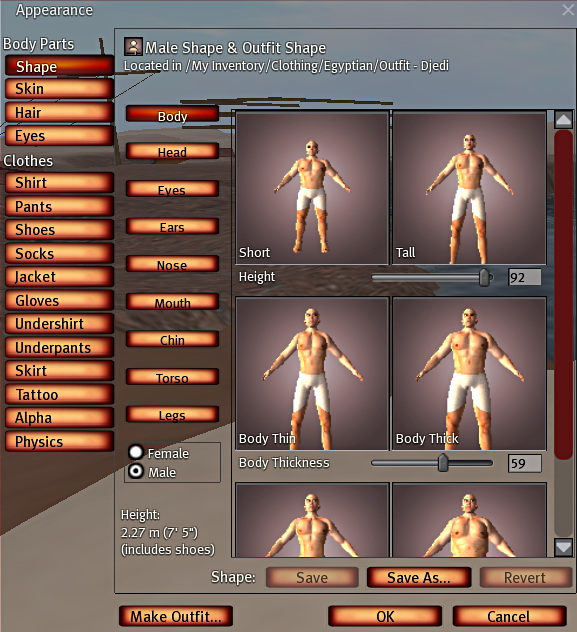There are two basic types of avatars in Second Life, those which are made by customising the default human avatars, and those which are constructed of prims. In the case of the former, one can easily customise all the physical characteristics of one’s avatar including, but not limited to; sex, height, body shape, muscle tone, clothing, hair and facial detail by using the inbuilt appearance editor (see figure 8). This is user customized content, but the appearance editor also allows residents to upload their own textures and skins. I feel that this being done, it becomes user created content. The appearance editor contains an amazing array of options and is one of the most powerful avatar creation tools I know of.

In the case of prim avatars, which are true user created content, one must construct or buy the avatar. A search of the Second Life Marketplace, just one of many websites that offer items for sale for use in Second Life, reveals that there are over ten thousand avatars listed for sale as at February 2011. Residents devote a lot of time and money to the careful creation of their avatar1 2 3, in fact, the process of creating one’s avatar when one signs up for Second Life is an important part of the process of becoming a resident. The amount of time and effort it takes serves to form an emotional attachment between the person and the avatar4, most especially with avatars that are constructed to look like the human operator. Constructing an avatar can be a powerful psychological process as “externalizing an aspect of our personality allows us to control that aspect rather than be controlled by it”5.
There is another part of the avatar which no one but those of us who look under the hood and fiddle with things think about. This part is called the agent. Strictly speaking the avatar is the graphical representation alone. The agent however is a part of the avatar that has no form. It is the means by which the avatar sends and receives the messages that control the avatar’s actions to the server, so that the avatar’s actions are represented accurately in the world to others6. These messages include such things as the avatar’s position in the world, whether or not the avatar is flying, and messages to pay or extract payment. This is important when one is scripting objects which control the avatar, for example animation scripts. It is the script which has agency. The avatar is the means through which one sees that agency in effect in the world. When the avatar is not being controlled by a script but rather by a person it is that person who has agency. The agent is rather like my conception of a soul. A soul is the means by which our physically manifest self can maintain a link to our non manifest self. Information can flow both ways, but our manifest self, like the avatar, may not be aware of these messages travelling in the background of our consciousness.
- Boellstorff, T., (2008), Coming of Age in Second Life: An Anthropologist Explores the Virtually Human, Princeton University Press, Princeton, p. 129. ↩︎
- Meadows, M. S., (2007), I, Avatar: The Culture and Consequences of Having a Second Life, New Riders, Berkeley, pp. 48-49. ↩︎
- Ondrejka, C., (2004), “Escaping the Gilded Cage: User Created Content and Building the Metaverse”, New York Law School Law Review, Vol. 49, No. 1, p. 88. ↩︎
- Meadows, M. S., (2007), I, Avatar: The Culture and Consequences of Having a Second Life, New Riders, Berkeley, pp. 96. ↩︎
- Meadows, M. S., (2007), I, Avatar: The Culture and Consequences of Having a Second Life, New Riders, Berkeley, p. 96. ↩︎
- LSL Wiki, Agent and Avatar, http://lslwiki.net/lslwiki/wakka.php?wakka=agentandavatar, Accessed 09/02/2014. ↩︎